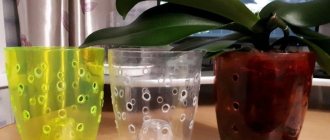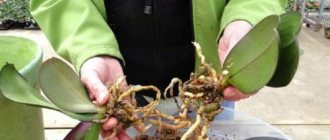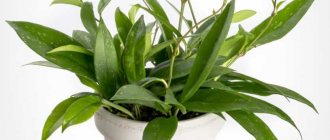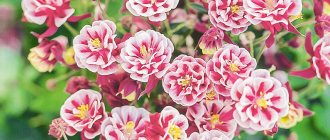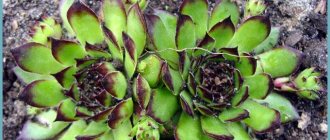Seedling care
After one month, the first cyclamen loops should appear on the surface.
Care plays a huge role in their further development. After the first shoots appear, the container must be moved to a room with good lighting. There should still be particles of the seed coat remaining on the tops of these sprouts. If the humidity is sufficient, they will fall off on their own. If these scales interfere with seedlings, they can be wrapped in a damp cloth for several hours. After this procedure, the husk will disappear. When 2-4 true leaves appear on young plants, they can be transplanted into separate pots. Typically, 100 ml plastic cups are used for these purposes. Holes must be made at the bottom for drainage. The composition of the soil should be the same as that used for crops. The soil mixture is filled into cups up to half the volume, after which the sprout and tuber are placed and covered with the rest of the soil.
The surface must be carefully crushed, trying not to harm the fragile seedlings. The soil above is watered abundantly
If in 3 months these flowers increase in growth slightly, then do not worry. As a rule, during this period, plants intensively grow only the root system. Grown-up cyclamen are transplanted into a pot with a diameter of about 5 cm. To plant cyclamen in a pot, you can use a universal soil mixture, which is sold in stores for indoor plants. A drainage layer is placed at the bottom, which should occupy a quarter of the entire volume of the pot. The tuber is not completely buried in the soil; about a third of it should be located on the surface.
How to water cyclamen? Watering is carried out through a tray. Thanks to this, you can avoid rotting of the cyclamen tuber.
As for feeding, the first of them is carried out at the age of 6 months. For this, complex mineral fertilizers are used, but the concentration of the solution should be halved.
Pot for cyclamens
Before the transplantation and planting procedure, you should select and prepare a flower pot for cyclamen. The dimensions of the latter depend on the age of the plant.
Cyclamen is watered from below, so when choosing a pot for cyclamen, pay attention to this model
If the flower is 1 or 1.5 years old, the diameter of the vessel will not be more than 8 cm. If the pot diameter is 15 cm, a 3-year-old flower is perfect. Also, do not forget that the distance between the tuber and the edge of the flowerpot itself should not exceed 3 cm.
To prevent excess moisture and the onset of rotting of cyclamen, expanded clay or ordinary pebbles should be placed in the pot.
There are several methods for propagating such plants at home, but propagation using seeds gives a high probability that the number of these very beautiful and easy-to-care indoor plants will increase.
Step-by-step disembarkation
Sowing begins with the preparation of the necessary components and the planting material itself.
It is important to follow the instructions so that planting cyclamen seeds at home will end in success. Be sure to select the correct soil and container, as well as process the material
Preparation of material
Preliminary preparation of seeds will help to plant the plant correctly. There are several ways to do this:
- Soaking with Fairy or other dishwashing detergent. Add a few drops of detergent to a container of water and immerse the material. The container should stand for three days, and the liquid should be replaced with fresh one every day.
- Potassium permanganate. To make the solution, several manganese crystals are poured with water at room temperature so that the liquid becomes slightly pinkish in color. The seeds are soaked for about 15 hours.
- The third option involves the use of special preparations that can be purchased at the same flower shop. The instructions for their use are usually found on the packaging.
- And the easiest way is to simply fill the planting material with cold water for a day.
Soil selection
The soil should be light so that it is easier for seedlings to break through. You can purchase it in specialized departments or try mixing it yourself.
Calla lilies in a pot: planting and care at home
If you want to use the second option, then peat, which is combined with leaf humus in a 1:1 ratio, is suitable for this purpose. After which the resulting mixture is sifted, removing dirt and larvae, and disinfected. Again, there are several ways to do this:
Calcination. Can be done in the oven or microwave. The soil is poured onto a baking sheet or into a bowl with low sides and placed in the selected unit. Exposure time is 10−15 minutes. Use of steam. Steaming is also an excellent option; a water bath is suitable in this case.
But it is important to remember that after the procedure the soil should stand for at least a week and only then be used. Treatment with potassium permanganate. Pour a hot solution of manganese into the soil and allow it to dry completely.
Planting process
When starting this stage, the work surface is covered with oilcloth, and gloves are put on your hands, although this is not necessary. For work you will need: a container (it is better to take a square one, not very deep, but wide), soil, water, seeds and a lid for the greenhouse. The process itself is as follows.
- Holes are made in the bottom of the box if they are not provided for in the design.
- The first layer is polystyrene foam or pebbles.
- Next, evenly sprinkle soil on top with a layer of 5-6 cm.
- The soil is moistened with water.
- Seeds are placed on damp soil at a distance of at least 3 cm from each other.
- Soil is again poured on top, but the thickness of the layer should not exceed 1-2 cm.
- The last step is to spray the soil with a spray bottle. This is necessary to moisten the soil, but at the same time not wash it away.
Caring for pelargonium at home
This completes the sowing. All that remains is to cover the box with glass and put it in a cool place.
Soil for cyclamens
For full and effective growth, the soil for cyclamen must be very loose and contain a high content of organic elements. The acidity of the soil also plays an important role, whose optimal value should be in the range of 5.5 - 6.5 pH. For these plants, crushed peat, leaf and turf soil, coconut fiber, sawdust and humus are perfect.
Video “How to determine soil acidity”
Before planting cyclamens, the soil should be disinfected. To do this, a small amount of earth should be evenly distributed on a baking sheet or a regular frying pan and kept for 10 - 15 minutes at a temperature of 80º C.
Reproduction methods
tuber
At home, cyclamen can be propagated by a tuber, even in two ways: either by dividing an existing tuber, or by using daughter formations. It is correct to use the tuber after the plant has completed the flowering process. The formation is removed from the soil, dried and divided into several parts. Each of them must have at least one kidney and full healthy roots. The wounds are treated with ash or crushed activated carbon. Don’t forget about disinfecting the tools you use.
After this, it is enough to plant the pieces in nutritious soil and water them so that the plant has enough moisture, but not in excess. If you overwater the planting material, it will rot. It should be mentioned that when propagating Persian cyclamen by tuber, it should not be completely buried in the ground, but one third should be left above the surface. In addition, it is worth pre-heating the soil mixture and then pouring boiling water over the cuttings.
Cyclamen reproduces by daughter tubers. The step-by-step guide in this case is very simple: just separate the daughter formations and plant them in separate pots. In this case, the substrate should also be nutritious, and irrigation should be plentiful, but not excessive
When performing the procedure, it is important that the entire tuber is covered with soil.
Seeds
It will be possible to propagate the plant by using seeds, but in this case the cyclamen will require long and thoughtful care. The first flowers in this case will sprout only after 1 year, and sometimes even in the third or fourth. The seed is first left for 12 hours in water or in a damp gauze in which a growth enhancer is dissolved. The planting itself is carried out in watered soil, placed in a container with holes in the bottom and drainage in the form of expanded clay. The substrate layer should be 8 centimeters. The seeds should not be deepened - just spread them out so that there is about 4 centimeters between the individual seeds.
Everything is sprinkled on top with a 1 centimeter thick substrate, and the container itself is covered with plastic wrap or covered with glass. When the first shoots hatch, you can remove the shelter to allow the sun's rays to calmly reach the cyclamen. After about 3 months, small tubers will form and full leaves will sprout. Each sprout can be planted in a separate pot, sprinkling soil on the root system. For the first 14 days, the plants are fed with ammonium sulfate, and after another 2 weeks - with potassium sulfur.
Leaves
Propagation by leaves is considered a more complex method. In this case, the leaf blade should already have small roots. Such a shoot is planted in moist soil and covered with a glass jar. Such a leaf has the ability to hatch successfully. However, it should be mentioned that leaves with roots are characteristic only of European cyclamen, and in the case of Persian cyclamen this technique will not work. In addition, most often the leaf, after standing in water, rots at the bottom and dries out at the top. It is still recommended to use this method only for experienced specialists.
Rosettes
The most effective way is considered to be the propagation of cyclamen by rosettes, which are also called horns. This term refers to shoots on tubers. In mature plants, they are usually of sufficient length, so they are easy to break off and plant in damp soil. The container is closed on top with a transparent glass jar or covered with a plastic bag. If the room is maintained at a moderately warm temperature, roots will begin to appear in about 2 weeks. Then the cyclamen can be cared for as a full-fledged adult plant. When choosing this method, you should understand that you should not take more than one horn, otherwise the flower will simply die.
Propagation by leaves
You can also get a new bush from a leaf, but only if you first germinate it. Germination occurs in water, and this is the problem. Often the succulent petioles rot before the roots appear. To speed up the process, do not cut, but tear off the leaf with your hands, trying to ensure that the heel, part of the onion, also comes off. Once roots have formed, plant the cutting in the ground.
European cyclamens reproduce mainly by leaves. The handsome Persian is unlikely to please you with success.
Methods for propagating cyclamen
Propagation of cyclamen by dividing tubers and subsequent planting of rosettes leads to the fact that young cyclamen will bloom within six months, and with seed propagation - no earlier than a year, but most often flowering occurs after 18 months.
The main condition for success during propagation is the correct selection of the appropriate soil: the better the quality of the soil is chosen, the faster the young plants will take root and develop fully.
The soil mixture for cyclamen must be fertile and loose, and consist of peat, leaf soil and a mixture of humus.
If a ready-made substrate is used for propagation, it must be mixed with steamed garden soil. You need to add a little sand to the soil mixture: this will allow the soil to drain water well and will not compact over time. A drainage layer must be placed at the bottom of the pot so that the roots of the plant receive oxygen and there is no stagnation of moisture.
Propagation of cyclamen by dividing tubers
When and how to divide tubers
By dividing tubers, propagation of cyclamen is usually carried out during the dormant period, that is, after the end of winter flowering, this moment most often occurs at the beginning of spring.
The tuber must be carefully removed from the ground, dried and cut into several pieces with a very sharp knife.
When cutting a tuber, it is important to ensure that each part of the tuber formed has roots and buds.
All sections, in order to avoid any infection, must be treated with activated charcoal or charcoal and dried a little in the shade.
Planting tubers
Tubers are planted in prepared soil in the fall. They cannot be completely buried in the ground; they are laid on the ground, pressed lightly and sprinkled with a little earth on the sides; the upper part of the tuber should be located above the ground.
Features of care
Watering should be regular, but not very abundant, to prevent rotting. Cyclamen can tolerate mild drought much more easily than stagnant water.
Lighting should be diffused.
Any type of cyclamen is a plant that prefers cool weather, so the most optimal temperature for cyclamen is 15-18 degrees; if cyclamen is kept near heating devices during propagation, the plant will die.
When young leaves appear on the tubers, this indicates the normal development of the young plant.
Cyclomen care at home is not particularly difficult, it blooms for a long time and is very beautiful!
Pests of Cyclamen
The cyclamen mite is a microscopic arthropod, it is very difficult to detect on a plant, very often only by indirect signs: the affected plant suffers mainly from young leaves - their edges curl, new leaves open and grow deformed, the buds are curved and do not open, withering.
Control measures. Cut off all affected parts from the plant, spray with an acaricide (Apollo, Vermitek, Sunmite, Actellik, etc.)
Thrips is a small flying insect with a spindle-shaped dark body that often lands on home flowers from bouquets and garden cuttings. Thrips are detected when light spots appear on the upper side of the leaf, gradually merging into large discolored spots. The upper side of the leaf becomes grayish-brown with a silvery sheen.
Control measures. Remove severely damaged leaves. A more convenient way to combat thrips is by watering with the systemic insecticide akrata (repeat after 7-10 days).
(See "pests" for more details)
Rules of care
Lighting
Cyclamen does not like direct sunlight, so it is better to place it on northern, western and eastern windows. In winter, when the amount of light decreases, it can be moved to southwest or southeast windows.
During the dormant period, the pot with the tuber is placed in a shaded, cool room. This can be a shaded place on the balcony or terrace. Some people place a pot with a tuber under the bathtub for the summer. But at the same time, we must not forget to water the soil once or twice a month with a small amount of settled water.
Temperature
When the room temperature is above 17-18 degrees, it is necessary to increase the air humidity. It is not recommended to spray cyclamen. You can spray water into the air around the plant, making sure that the droplets do not fall on the plant. But the best way is to place the pot with cyclamen on wet pebbles or expanded clay. In this case, the pot should not stand in water, otherwise this will lead to rotting of the tubers.
The watering regime for cyclamen is determined by the period of flower development. During the period of leaf appearance and flowering, watering is done more often to prevent the earthen clod from drying out. Watering is carried out with settled water at a temperature a couple of degrees below room temperature. As the leaves begin to wilt, reduce the amount and frequency of watering.
During the dormant period, infrequent watering with a small amount of water is carried out. Water along the edge of the pot to prevent moisture from getting on the tuber. Watering a flowering plant is carried out through a tray, pouring out the remaining water after an hour. You can lower the pot into a container of water for fifteen minutes so that the water does not reach the edge of the pot. This method is suitable for a clay pot whose pores allow water to pass through. A plant in a plastic pot is watered through a tray.
Top dressing
From the moment the leaves appear until the end of the flowering period, cyclamen must be fed. Use complex fertilizers for beautifully flowering plants. Perform two feedings per month. In summer, during the dormant period, cyclamen is not fertilized.
Cyclamen prefers light and loose soil, neutral or slightly acidic. If you prepare the mixture yourself, you need to take leaf and turf soil, peat and sand in equal quantities. Another mixture is also suitable for growing cyclamen:
- leaf soil (3 hours);
- peat (1 tsp);
- sand (1 hour).
Transfer
The plant is replanted after the end of the dormant period, when young leaves begin to emerge. First you need to select a pot according to the size of the tuber.
There should be holes at the bottom of the pot for water drainage. First, a layer of expanded clay is poured. Then an earthen mixture is added, which must be heated in the oven for half an hour before planting to kill bacteria. After all, cyclamen tubers are easily susceptible to disease.
When replanting, it is not recommended to clear a healthy tuber of old soil.
The exception is diseased plants and recently purchased ones. The tubers are inspected for the presence of rot, the rotten parts are cut out, and the cut is sprinkled with crushed activated carbon. Purchased plants are planted in soil with a large amount of peat to accelerate growth. Therefore, you need to transplant the cyclamen into more suitable soil.
Young flowers up to five years old are replanted annually. Adult plants are transferred to a new pot, first once every two years, and then after three years.
Let us pay attention to one subtlety when caring for cyclamen. When the flowers fade and the leaves dry out, they must be removed.
Removing faded flowers lengthens the flowering period, promoting the appearance of new buds. But be sure to perform this procedure correctly. Do not pick or cut off old flower stalks and leaves.
Cyclamen - care at home
Loading …
By providing the plant with proper care, you can admire butterfly flowers for many winters, because they appear at the end of autumn and delight the eye until spring.
Cyclamen, the care of which consists of creating optimal conditions, sheds its leaves in the summer. During the dormant period, it needs a cool room.
Temperature, location and lighting
The cyclamen flower lays buds during the dormant period. The plant reacts painfully to high temperatures. It is optimal to grow an overseas guest at 10-15 degrees in winter. At higher rates, leaves and flowers are dropped.
Cyclamen should be gradually accustomed to warmer conditions. Flowers are placed on the windowsill under a window, which is periodically opened to bring in fresh air. Ideal window location: east or west - in summer, south - in winter.
Cyclomenia hybrids differ in the size and tone of the buds. The Persian variety feels excellent at a temperature of 20 degrees, but is afraid of sunlight.
The plant is suitable for diffused light without exposure to sunlight. If there is a strong flow of sun, it is worth moving it to a western window or shading it to a southern one.
Air humidity
Cyclamen loves moist air. Conditions of high humidity in an apartment can be created in different ways:
- Spraying leaf plates. During flowering, the plant is not sprayed, as the decorative effect of the buds is reduced;
- By creating a water mist around the plant;
- Placing containers of water near the flowerpot.
Watering and soil
The light-loving plant requires frequent watering, using a small amount of water, the temperature of which is several degrees lower than room temperature. Cyclamen is watered at the root - during the growing season and in the pan - at the time of flowering. During the dormant period, the plant is watered very carefully, without waterlogging.
When learning how to care for cyclamen, you should pay attention to the composition of the soil.
It is important for the plant to create aeration - high air permeability. Professionals recommend the following soil composition:
Professionals recommend the following soil composition:
- 1 part leaf soil;
- 1 part humus;
- 1 part peat;
- 1 part sand.
Transplantation and propagation of cyclamen
Many people are interested in how to transplant cyclamen correctly. The plant's soil is changed if absolutely necessary (after purchase, infection, or in case of a decrease in the abundance of flowering). When replanting, the bottom of the flowerpot is covered with drainage and filled with prepared soil. The tuber is planted in the ground to a depth of 1/3 of its size or at the same level with the soil. The time of planned replanting is the beginning of the dormant period (yellowing of the leaves, cessation of flowering).
In apartment conditions, the lifespan of cyclamen is 7-10 years. You can preserve the variety by propagating the plant yourself. Having learned how cyclamen reproduces at home, you can correctly perform the procedure. Experts advise dividing the tuber only of a plant that has several growing points. Cut the planting material so that each specimen has an eye. Only use a very sharp knife and disinfect the cuts on the tuber.
The second method of propagation is the use of seeds:
https://youtube.com/watch?v=EV7g1EvqoAM
- Sowing takes place at the end of March;
- The temperature of the crops is 18 degrees;
- Germination occurs in a dark place (if necessary, containers with crops are covered with opaque film).
Indoor cyclamen are amazing flowers that delight people with bright colors in winter. Professionals recommend that you definitely try to make friends with a charming overseas guest by placing him on the windowsill.
Features of caring for cyclamen at home
Another name for cyclamen is Alpine violet. The homeland of this flower is the Mediterranean. Many flower growers compare cyclamen to a flock of bright butterflies perched on greenery: its flowers are so beautiful and unusual. Their color can be very diverse: bright scarlet, snow-white, pink, red, crimson, peach, purple. And these are not all shades. It should be noted the variety of flower shapes: large or graceful, miniature. There are always a lot of flower stalks: 10-15.
Temperature
First you need to choose a suitable room. It cannot be said that this flower is very whimsical, but it needs ventilated rooms that are well lit. The temperature can be quite cool: +12-15 C, but there should be no drafts. In cooler temperatures, flowering even lasts longer. Cyclamen prefers nutritious and loose soil. You should not purchase a pot that is too large, since cyclamen is a small indoor plant. You need to plant the flower in a mixture of turf, leaf, humus soil and sand. The ratio is: 2:1:1:1.
Watering
The flower needs good and regular watering, but stagnation of moisture is undesirable. It’s great if the pot has a tray, then you should water it into it. This will prevent water from getting to the top of the tuber. Cyclamen loves a humid atmosphere, so it can be sprayed with plain water from all sides. But this should not be done during the flowering period. Proper watering is especially important during the growth period. Water should only be used that is warm and settled. This is necessary to keep the flower healthy.
Fertilizers
Fertilize cyclamen during the flowering period twice a month. To do this, use various types of liquid flower fertilizers. The concentration is as follows: 0.5 caps per two liters of water. The water should be warm and settled. Try to fertilize so that the liquid does not get on the flowers and leaves. You can use a fertilizer called “Floretta” for feeding.
It is very important to fertilize with chlorine-free fertilizer. Cyclamen does not welcome an excess of mineral salts, so mineral fertilizers must be applied in small quantities
Fertilizing is carried out in this way: you must first water the soil and wait until it is saturated, then you can fertilize it.
When planting on your own, it is not recommended to feed the flower before the first shoots appear. A young plant or one that has just been transplanted does not need additional feeding for six months. Fertilizers should only be applied when the plant is healthy.
Peculiarities
At home, it is customary to grow two types of cyclamen.
- The European one is a flower whose height reaches 30 centimeters. The flat leaves are covered with green and silver skin, and their underside is painted purple. In this case, the tuber becomes immersed in the substrate. The flowers grow white, pink or purple.
- Persian cyclamen differs from European cyclamen in the color of the leaf blade - purely green on the inside, as well as in the protruding tuber. The flowering periods of these two varieties also differ.
Indoor cyclamen can be propagated successfully in several ways. If you choose the seed method, it is recommended to first create and collect seed yourself, since purchased material has poor germination. To do this, over the course of several days, pollen is transferred from the flowers of one cyclamen to another using a soft brush. If pollination is successful, the peduncle will begin to thicken and curve. A box filled with seeds will gradually form.
The seeds do not need to be dried, but before planting they will have to be soaked for one day in a liquid enriched with a stimulant and several crystals of potassium permanganate.
Most suitable for cyclamen is a ready-made substrate intended for succulents. You can make a mixture yourself from peat and leaf compost, taken in equal proportions. It is poured in a layer of 6 or 7 centimeters. The bottom of the container must be covered with a high-quality drainage layer. It is assembled either from expanded clay or from small foam balls forming a thin layer.
The height of the drainage should be from 2 to 2.5 centimeters in order to be able to protect only the formed roots from excess moisture. The laid out substrate is spilled with liquid so that the excess can drain through the holes at the bottom.
It is important to mention that any components taken from the garden must first be disinfected: either calcined in the oven or doused with boiling water.
Possible problems
If the leaves of young cyclamen begin to turn yellow, the cause may be both high temperature in the apartment and dry air. Often the reasons are combined. To prevent this situation, containers with plantings should be placed on window sills, under which there are no batteries, and regular spraying should be carried out. Alternatively, the pots can be placed on a tray filled with constantly moistened pebbles. To quickly correct the situation, cyclamen will have to be immediately removed from the battery, moved to a room where the temperature does not exceed +18 degrees, and spraying should also begin.
When the flowers are healthy, but the leaves still turn yellow, the problem may be excessively high temperatures. By returning the readings to +18 degrees, it will be possible to eliminate the problem. Sometimes leaf blades turn yellow due to the fact that the substrate is not sufficiently moistened. It is clear that in this case it is enough to simply increase watering frequency. Finally, the leaves may turn yellow and fall off after the cyclamen blooms, which is an absolutely natural phenomenon. This phenomenon suggests that the plant is simply adjusting to a state of rest. If the leaf shedding is too intense, it is better to move the plantings to other rooms.
When the root system begins to rot, the problem may lie not only in excess liquid, but also in the fact that it pours directly onto the top of the tuber - its rosette. Otherwise, the core of the flower not only rots, but also becomes moldy. If cyclamen leaves begin to deform, this may indicate pest attack. The miniature cyclamen mite cannot be seen on the surface of the leaf blade, but its impact leads to curling of the leaf edges and cessation of their development. In such a situation, the damaged parts of the plant should be immediately eliminated, and then all plantings should be treated with insecticides.
Gray mold occurs when the plant is kept in high humidity and the temperature remains too cold. As preventive measures, experts advise regularly ventilating the room and keeping the temperature at +18 degrees.
You will learn more about propagating cyclamen at home in the following video.
Reproduction
Cyclamens are propagated from seeds at home. The European species, alpine violet, can be propagated by dividing the tuber. When flowers appear, they are pollinated with a soft brush to produce seeds.
Dividing a tuber is considered a complex manipulation; it may not work the first time, but with this method flowering occurs faster. Seed propagation of cyclamen is less complicated, but it will take patience to wait for the seedlings - they grow approximately six months after sowing.
In adult strong cyclamens, daughter bushes appear - they are separated from the mother plant and transplanted into separate pots.
The advantage of propagation at home is that the flower gets used to certain conditions and does not get sick when transplanted.
Seeds
It is 80% likely that the seeds will sprout, so amateur gardeners most often use this method.
Sowing should begin in August. To sort the seeds, they are poured with a 5% granulated sugar solution. If the seed floats, it is removed - there will be no shoots from it.
Next, dissolve Zircon and immerse the seeds in it for a day - this promotes germination. Peat mixed with vermiculite is poured into the container. The mixture should be wet. The seed material is scattered over the surface and lightly sprinkled with soil on top. Cover the container with glass or cling film.
The temperature at which seeds germinate is 18 - 20 degrees. It needs to be supported. Shoots appear in 1 - 1.5 months. After the foliage appears, the greenhouse is opened and the container is placed in diffused light. At this moment, the temperature should be slightly reduced - to 15 degrees.
How to care for cyclamen at home after germination:
Picking and replanting are carried out in new soil, consisting of 1 part of red high-moor peat, 2 parts of leaf and turf soil from the garden, 0.5 parts of clean sand. When replanting, small tubers are sprinkled with soil.
A week later, apply fertilizer consisting of equal proportions of nitrogen, potassium and phosphorus, but take half the specified dosage.
In the spring, when the cyclamens enter a period of hibernation, they are replanted again, leaving the tubers protruding a third from the soil.
With proper care, alpine violet begins to bloom a year or more months after sowing.
Tubers
Reproduction and care of cyclomenia flowers can be done by dividing the tuber. This event takes place during the dormant period. The bulb is removed from the soil and dried to remove any remaining soil. It will become clear where the sprouts are. You need to divide it into so many parts that each has a growing point and roots.
The sections must be dried and treated with brilliant green for disinfection. You can use activated carbon or Kornevin solution. This is a rather risky method, since you can destroy both the mother plant and the sprouts. To avoid rotting, it is necessary to calcinate the soil in which new plants will be planted. At high temperatures, most fungal spores die.
Advice! It is more profitable to use brilliant green for disinfection - there is a greater chance that the divisions will take root
When to replant cyclamen
The plant can be replanted in the period after the flowers fall and before the next buds begin to form. An annual transplant is needed to renew the flower and stimulate the growing season.
The vegetative year of a flower should be divided into a period of dormancy and flowering. During hibernation, fertilizers are not applied to crops, watering is minimal, and the air temperature in the room is increased. This is a good time to replant the plant, as it is less susceptible to stress.
Note! Over time, the soil becomes depleted and the crop does not receive enough nutrients. By external manifestations you can understand when you can replant cyclamen
If, under the right conditions, the bush does not bloom for a long time and begins to dry out and the leaves turn yellow, you need to check it for pests. The above-ground part is carefully inspected. If the leaves are clean, you need to check the condition of the roots. The tuber may be affected by rot or insects. In this case, they are treated with an insecticide, the damaged roots are removed, and the tuber is transplanted into a new pot. In this case, flower growers recommend completely replacing the soil.
An adult plant may not fit in an old container. You should pull out the root and see how much space it takes up in the pot. If there is no more room left for the development of the tuber, transplantation into a new, more spacious pot is required.
Is it possible to replant a flowering plant?
It is not recommended to replant any crop during the flowering period. The plant devotes a lot of energy to the formation of buds, the opening of flowers, and the formation of seeds. Transplanting a blooming cyclamen will cause the buds to dry out, the flowers to fall off, and the adaptation process will be delayed. The next flowering will have to wait a long time.
For your information! Often the bush dies, since replanting during the growing season is stressful.
There are cases when it is necessary to replant cyclamen during the flowering period. These bushes are forced out for sale in a blooming state. When purchased, the bush inevitably dies after the petals fall. But he can be saved in time. In such cases, an emergency transplant of flowering cyclamen is done.
Flowering purple variety
First of all, all the buds and flowers are cut off and the bush is transplanted into new soil. The substrate should not be fertilized. It is best to plant the flower in depleted soil; you can add more sand. The culture is put into a dormant state, transferred to a cold place, watered little and not fed.
How to transplant cyclamen at home is described step by step in the next section.
Transfer
Care and replanting of the cyclomenia flower is carried out regularly, since the tuber and roots draw all the nutrients from the soil. During growth, the bulb enlarges and the small pot becomes cramped.
How to transplant cyclamen into another pot:
Choose the right time. Transplantation is carried out after the start of intensive growth, but before the formation of buds. A flowering plant cannot be replanted, even if the flower grows in a light transport substrate.
Inspect the tuber and select a pot according to size - it should be 5-6 cm larger than the bulb. There is no need to buy more, since the plant puts all its energy into growing the root system and forgets to bloom.
Place a layer of expanded clay or pebbles on the bottom. Place a 2 cm layer of prepared soil mixture on it.
Remove the flower from the previous pot and inspect the roots. If any of them are rotten or dry, they are removed.
Clean as much of the old soil as possible from the root.
Place the cyclamen in a new container. The upper part of the tuber must protrude from the soil, otherwise the growing point may rot.
Sprinkle the sides with soil and press down to release excess air.
To stimulate cyclamen to take root, it is not watered for the first 3 to 4 days and the plant tries to find water on its own. The leaves may droop a little, but then gain strength again.
Loose soil always settles, so add enough of it to the pot so that the soil is 2–3 cm below the edges of the pot.
Types of cyclamens
There are countless types of cyclamens. But there are only nine most common types, we will talk about them further. The homeland of this flower is the Mediterranean coast. Due to the rapid spread of the plant, the name of its varieties began to be assigned according to the place of growth, for example: Persian, European, African, etc.
- Persian cyclamen. The most popular type of this plant. It has many varieties. The most popular subspecies are “Barbadosa”, “Gabi” and “Orpheus”. The leaves of the Persian cyclamen are heart-shaped, rich green in color, and have a white marble-like pattern. The petals of the plant come in different colors: from white to purple. There is a hybrid of Persian cyclamen. It has a longer flowering period and comes in eighteen petal colors, unlike the common Persian drake.
- European trash. European cyclamen is also called blushing. Distributed in Italy, Macedonia, Slovenia. The leaves of the flower are basal, with a pointed tip and slightly jagged edges, and have a green-silver color.
- African cyclamen. Algeria and Tunisia are considered to be the birthplace of African cyclamen. There are two types of African cyclamen: tetraploid and diploid. They are distinguished by the smaller caliber of the leaves and the greater fragrant inflorescence of the diploid one.
- Alpine cyclamen. A distinctive feature of this variety of dryer is the special arrangement of the flower petals and their twisted oval shape. The usual arrangement of petals corresponds to 180º, for the alpine violet - 90º.
- Pontic cyclamen. Also known as “Colchisian”, “Abkhazian”, “Caucasian” cyclamen. This type of dryer is used for medicinal purposes and in bouquets. It is listed in the Red Book; unfortunately, there are too few representatives of this species left.
- Greek trash. Grows in damp places with light shade. The leaf color ranges between lime and dark green, and the flower color varies between pale and scarlet pink. In the 80s of the last century, a very rare subspecies of cyclamen with snow-white flowers was found in the Peloponnese, which is now listed in the Red Book.
- Kos cyclamen. As you already understand from the name, this cyclamen was bred on the island of Kos in the Aegean Sea. The base of the petals of this species is very bright, although this drake does not differ in the variety of petal colors from other cyclamens. But colors such as purple, red, white, pink are observed, they are more saturated and bright than other cyclamens.
- Cyprian Drunk. Loves bushy terrain with rocky soil and trees. The height of the plant is 8-16 cm. The leaves have a heart-shaped appearance, the color of the inflorescences is dominated by purple and pink shades.
- Ivy leaf cyclamen. Ivy-leaved cyclamen, or Neapolitan, is the most common plant in Europe. The original name of the flower, Cyclamen hederifolium, was given in 1789. The second, familiar to us - Neapolitan cyclamen - appeared in 1813. This type of dryer is the most frost-resistant, so it gets along well in the northernmost regions of Europe.
How does Persian cyclamen differ from European cyclamen?
Signs that will help distinguish the two types of plants:
- Persian cyclamens bloom in the autumn-winter period, and European-species plants bloom in the spring-summer period. The inflorescences of the Persian cyclamen were larger, but modern plant hybrids do not allow one to distinguish the two types of cyclamen;
- the reverse side of the leaves of the Persian cyclamen is green, with patterns possible, while the leaves of the European cyclamen have a purple tint;
- The tubers of the European-species flower are very flat and do not have “children”. The root system is present only in the lower part;
- The tuber of the purple type of cyclamen protrudes at the general ground level. In cases where the tuber is completely under the ground, it is a European flower.
Cyclamen persica
European cyclamen
What kind of plant is this?
Cyclamen is a perennial herbaceous plant from the Myrsinaceae family. It stands out for its bright and abundant flowering. Its inflorescences resemble a butterfly. They are located on long legs and rise above the foliage, forming a lush flower cap. The flowers come in a variety of colors, from pink to purple. The leaves, which form a dense basal rosette, look like small hearts, painted green with a silver pattern. They are located on petioles of a light green hue.
In nature, this plant lives in difficult climatic conditions, with low temperatures and unstable humidity.
Cyclamen can live up to 25 years, this happens due to the fact that the periods of rest and wakefulness change. In apartment conditions, these flowers live an order of magnitude shorter, since dry and warm air quickly depletes their tubers.
Characteristics
Before delving into the intricacies of how to care for a cyclamen flower, it’s worth learning more about it. A representative of the Myrsinaceae family, it is a perennial herbaceous tuberous plant. Under natural conditions, it grows in the warm, humid climates of the Middle East and Southern Europe. Even on the Black Sea coast you can find blooming cyclamen thickets. The culture includes more than 60 species, and 20 of them have taken root in our country. True, they do not grow in open ground, but in apartment conditions. The Russian winter is too harsh for a heat-loving plant.
The root system of cyclamen is a large tuber, similar to a flattened brown ball. In it, the flower stores moisture, without which it cannot survive, especially in the wild. The diameter of the tuber is on average about 5 cm, but there are real giants. Their simply huge tubers reach 15 cm in diameter.
Numerous thin auxiliary roots grow from the lower part of the tuber. And in the upper part there are growth points. From them, at the beginning of the growing season, leaves appear on long petioles. They have a very beautiful heart-shaped shape with a jagged edge. The main color is green, but the entire surface of the leaf blades is painted with silver strokes.
With the arrival of autumn, thin flower stalks begin to rise one by one above the lush foliage rosette. They bend gracefully under the weight of large flowers. Their elongated wavy petals are bent in the opposite direction, resembling the wings of a butterfly. Each lives for almost 2 weeks, and just one bush can produce up to a hundred buds. The natural color of cyclamen is pink-purple. But breeders have developed many varieties with a wider range of colors.
After flowering ends, the above-ground part of the bush dies off, and the cyclamen goes into hibernation. Only after resting will it be able to bloom again next season.
What it is?
Cyclamens are native to the Mediterranean and North Africa. You can find cyclamens in Cyprus and Palestine, Iran, alpine meadows and Greece. It belongs to the Myrsinaceae group, and also belongs to the primroses. The flower has many varieties, almost 70, they differ in size, flower characteristics, and coloring. About twenty species of cyclamen are domestic, have taken root well and grow in apartments.
The height of the plant can be from 15 cm to 35 cm. Its root is of the tuberous type, resembling a flattened onion dotted with small buds. The diameter of a cyclamen tuber is 4-15 cm. The foliage is light or dark green in color and may have streak patterns and spots of a light gray tone.
The peduncles are long, strong, of small thickness, covered in abundance with flowers; up to sixty buds can open on one cyclamen. The flowers themselves are small, slightly inclined downwards, with slightly bent petals. They look like butterflies hovering over a clearing.
There are quite a lot of varieties and types of plants, for example, Persian, Cyclamen Mix and others (you can find out more about Cyclamen Mix in this material).
Replanting cyclamen
Cyclamens are replanted in the spring. The flower is difficult to tolerate the procedure, so the root is transferred along with a lump of earth. You should not do a transplant more than once every four years. Do not touch the plant during the formation of buds and immediate dissolution.
Prepare the planting soil in advance, mix peat, humus, sand and leaf soil. Take all ingredients in equal proportions. Before transplanting, heat the composition in an oven or pour in a manganese solution.
If you keep an old pot, disinfect it. Do not take the new one too large so that moisture does not stagnate in the soil. There must be drainage holes at the bottom. The plant itself does not need preparation. A sign of its readiness for relocation will be the appearance of small leaves on the tuber after the dormant stage. This happens in the middle of summer.
Transfer rules
The procedure for transplanting a flower is simple. Follow a number of basic rules:
- Place drainage at the bottom of the pot: small pebbles, expanded clay or brick chips.
- Fill the container with the prepared substrate, but not to the very edges.
- Remove the plant from the old soil and lightly shake off the roots.
- Inspect the root system for rot. If there is one, cut off the affected areas and treat with crushed coal.
- Place the tuber in the center, carefully spread the roots throughout the volume. Fill the voids with the remaining soil, leaving the top of the root head exposed.
It is important not to injure weak radicular processes in the process. This will prevent the flower from quickly adapting to a new location.
After all the manipulations, water the cyclamen step by step. Wait until the water is completely absorbed into the soil, only then add a new portion. Then add the slightly settled soil mixture.
It is important to leave the top of the head slightly open. Place the pot in a bright place, but not in the sun
The first month after transplantation is very important. If you violate the basic rules of care, the plant will not take root and will die. Water moderately, without causing stagnation. Dampness leads to the development of putrefactive phenomena. Apply fertilizing after complete adaptation.
How can you propagate cyclamen?
In order to subsequently obtain a healthy plant with bright flowering, it is necessary to use the following methods of propagating cyclamen:
- tuber division;
- sowing seeds;
- rosette propagation;
- leaf division;
- propagation by daughters and tuber shoots.
Tubers
In the process, only mature roots are used; gardeners are recommended to carry out the operation during the plant’s dormant period. Division should be carried out when transplanting cyclamen.
To prevent the death of a flower, observe the following conditions:
- the root system must be dug up and dried;
- divide the tuber using a knife, with roots and buds on each part;
- to prevent infection, the cut is treated with ash and coal;
- parts are planted in the ground and watered;
- Do not overfill the tubers with water.
The propagation procedure by seeds is considered the longest. Gardeners sometimes use this method; some types of flowers are propagated only by seeds. Sowing is recommended in the second half of March. Germination requires sunlight.
Types of plants and their care:
- the genus of Persian flowers can grow in tropical climates;
- the European type is divided by the root system;
- the smell from the buds depends on the shade of the petals; the smell from the buds depends on the shade of the petals;
- African cyclamen develops when planted in early spring.
In answer to a common question from gardeners, the only answer is that planting cyclamen seedlings in open ground is possible. First of all, the soil is prepared in an area where fresh air is available.
It should be immersed in the soil to a depth of no more than 10 cm, while maintaining a distance between seedlings of at least 10 cm. For normal flower growth, it is necessary to prepare a plot of land with natural shade during the day.
In this case, the soil should consist of soil with rotted leaves of plants, a turf layer, rotted fertilizers, and fine sand.
Important to remember! Cyclamen is replanted with tubers; strong flowering begins after 7 months. In open ground, the plant can live up to 8 years without replanting. Gardeners are not recommended to flood the root system.
Tuber division
The tuber can be divided only when the plant has flowered. The tuber (see photo) is the most important and vulnerable part of the flower. Its division is an extreme procedure, so it should be carried out especially carefully.
This method of reproduction consists of the following steps:
- It is necessary to water the plant just before the procedure. This will make it quick and easy to remove the root from the pot.
- On the day of transplantation, remove the tuber from the pot by digging a little. Next, wash it with warm water, removing any remaining soil. After this, dry the onion.
- Now you need to take a sharp knife and disinfect it. After this, cut the tuber into two parts, and you need to divide the onion so that on each part there remains one bud, as well as several roots.
- Sprinkle the cut tuber with charcoal. If you don’t have such a component at home, then take regular activated carbon, it can also be used. There are gardeners who even use brilliant green, as it disinfects well. This will prevent harmful organisms from entering the damage. After this, put the onion in a dark place and leave for 2-4 hours. During this time, the tuber will dry out, and in the meantime you can prepare the soil.
- Take a medium-sized container with holes in the bottom through which excess water will flow out, and place expanded clay inside as the first layer. The second layer should be laid out with soil, which you can buy ready-made at a flower shop. Typically, soil for cyclamen consists of peat, humus and leaf soil. If possible, you can prepare the substrate yourself.
- Next, place the tuber in the soil and water it. Now it is necessary to maintain humidity, otherwise reproduction will not be successful.
After planting, do not place the flower on the windowsill, as most often it receives direct sunlight. For a newly planted tuber, such light will be destructive. The temperature for reproduction to be successful should be 14-16 degrees.
Important! For propagation by tubers, select only healthy bulbs. If after the cut you notice any damage inside, then refuse propagation and pick up another tuber.
To enhance and accelerate the growth of the tuber, you can spray it with special preparations for the growth of the root system. These could be: Grandis, Viva or other drugs.
